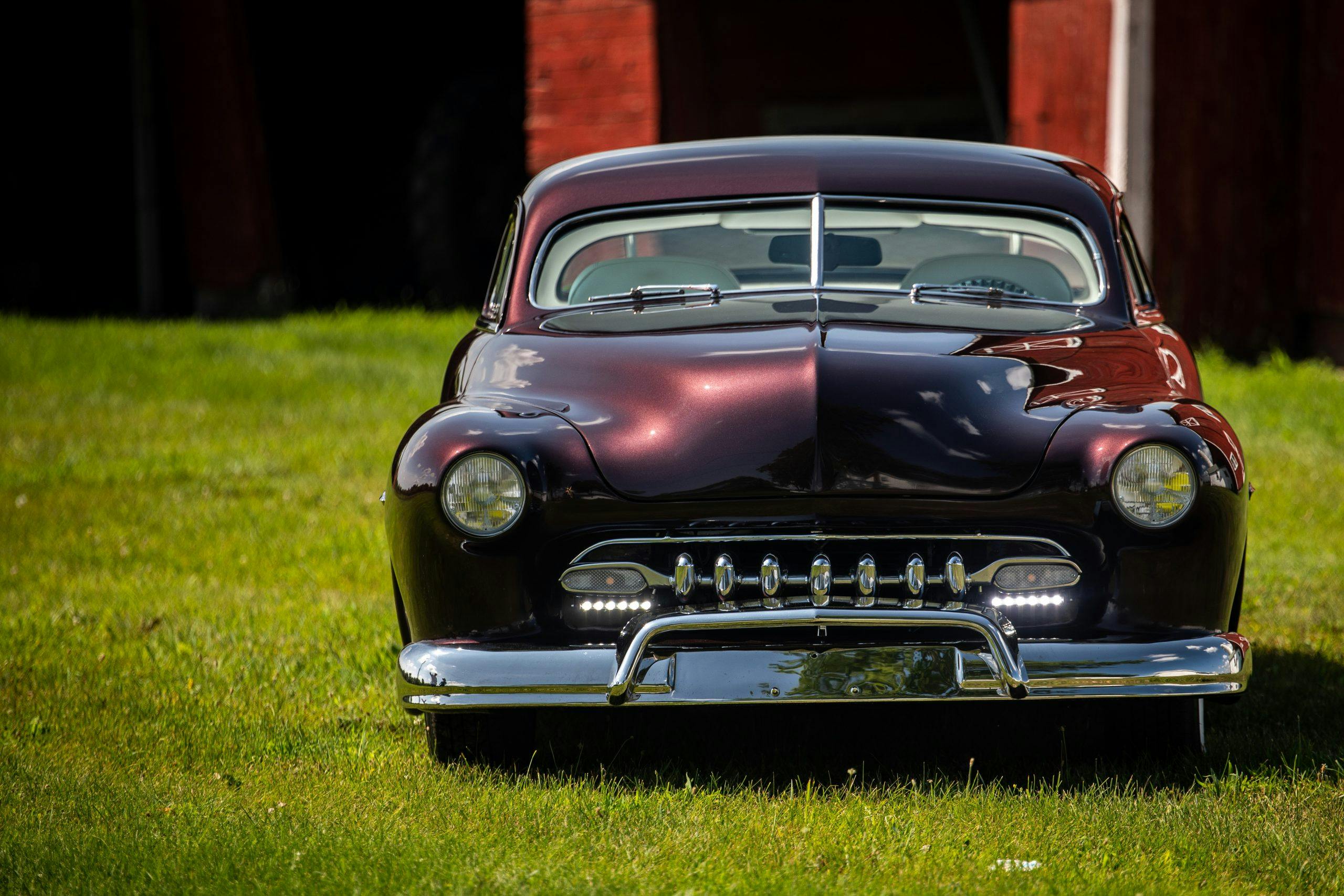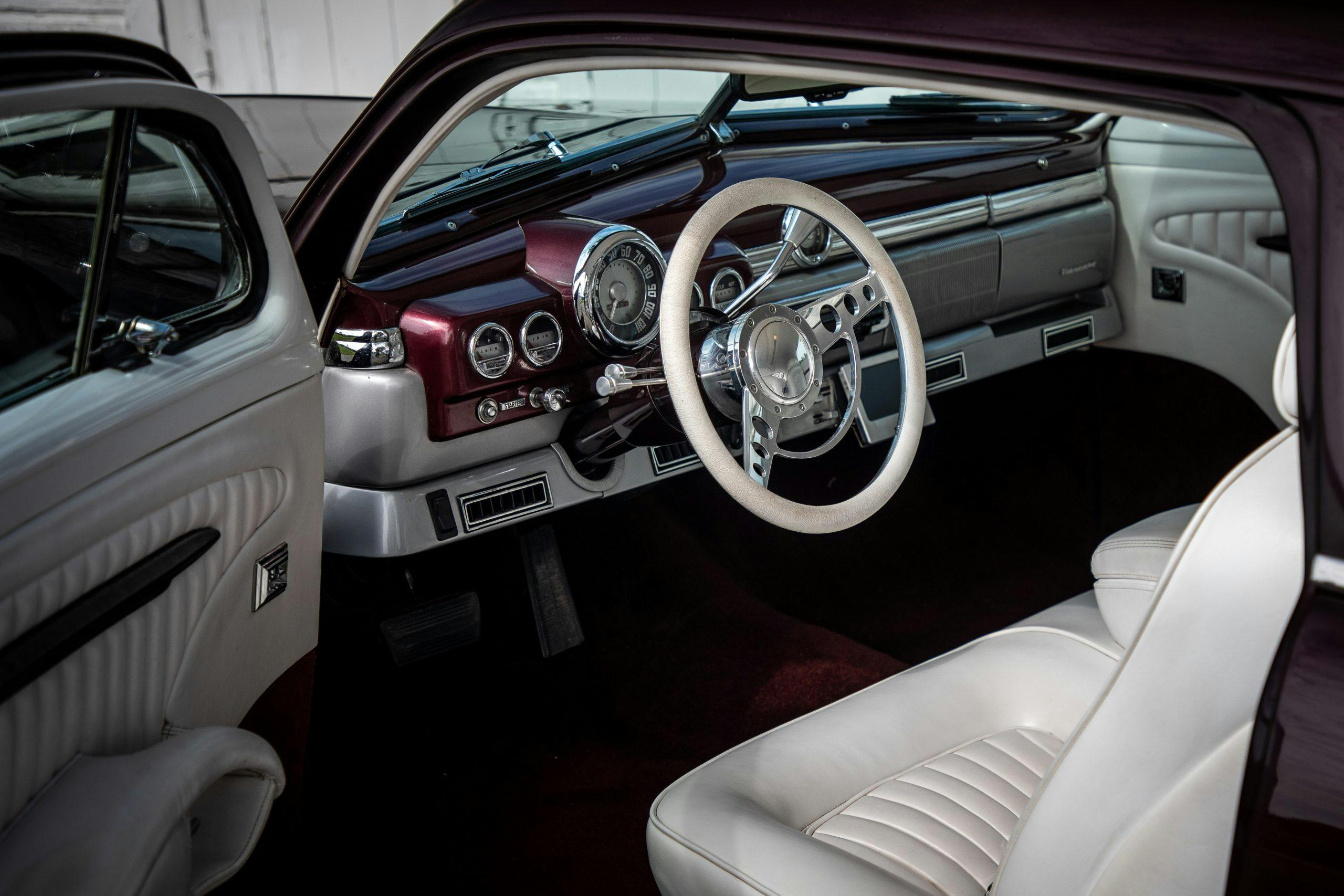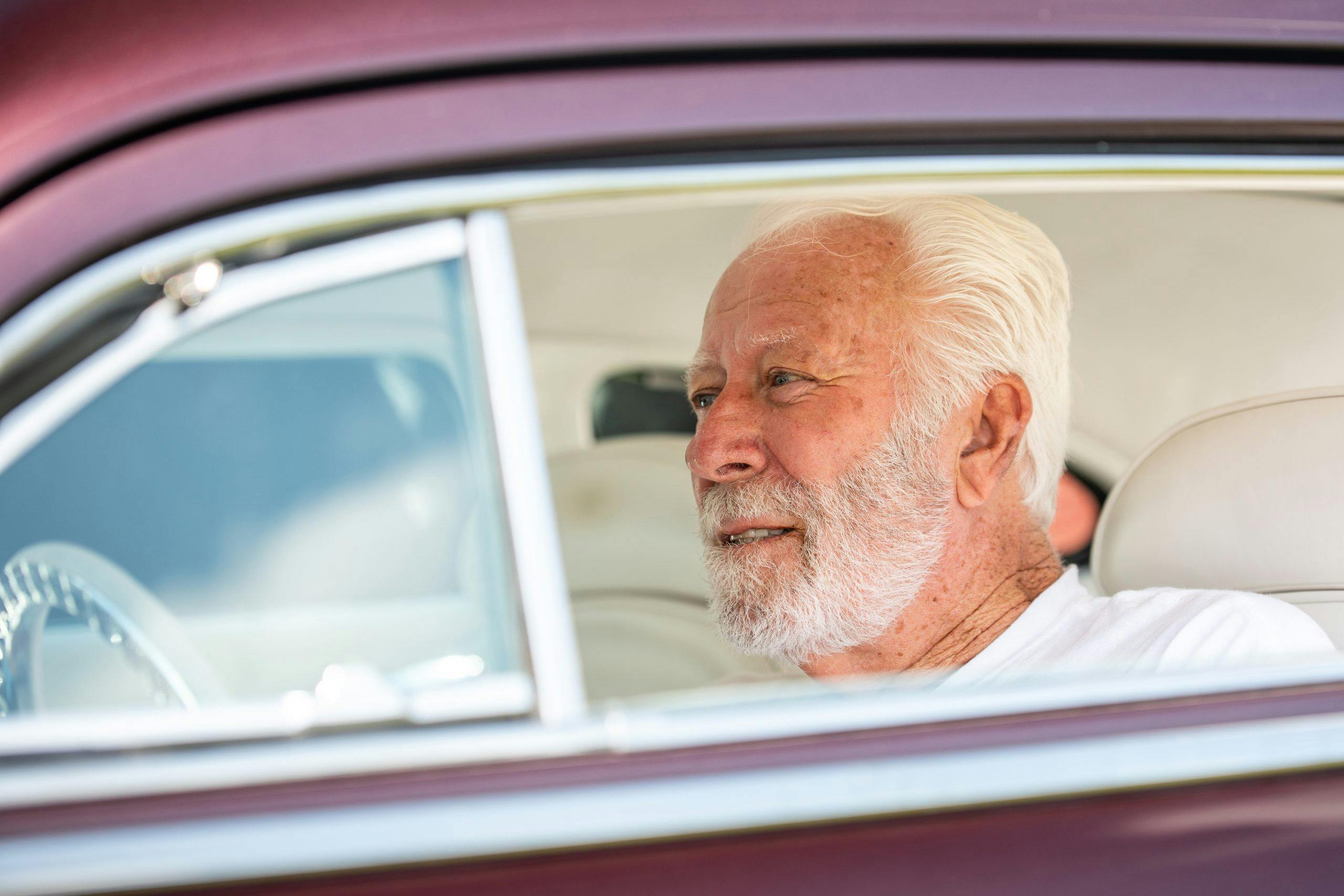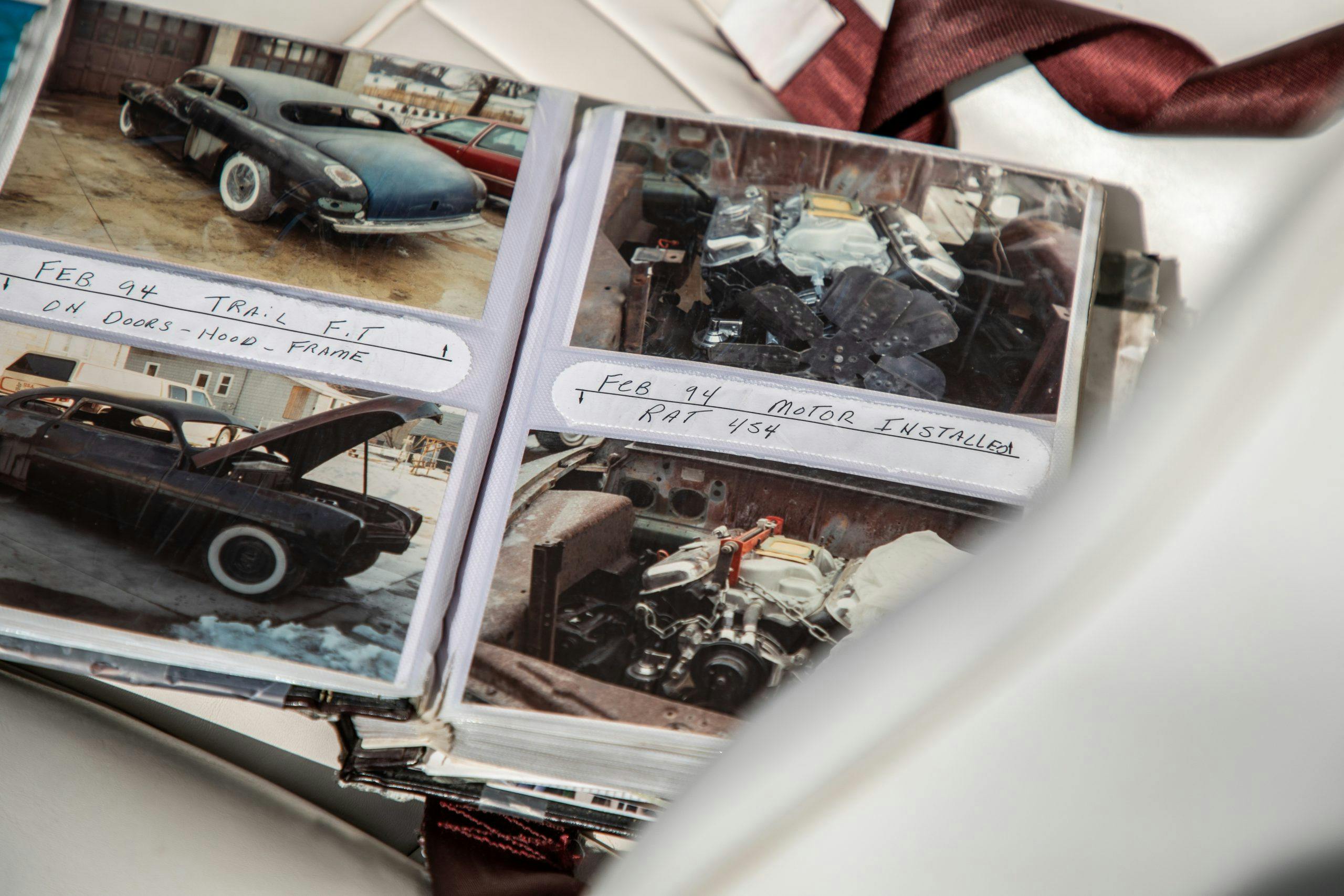This custom ’49 Mercury keeps the lead sled tradition alive and kicking
You may have hard the term “lead sled.” In the 1950s, these were the radical customs that nudged hot rods out of pole position. For a decade or so following the 1955 release of the epic James Dean flick Rebel Without a Cause, they were the rides of choice for every kid who didn’t squander prized lawn-mowing earnings on comic books and bubble gum.
Sonny Hall of Belleville, Michigan, was a teenager when he first saw Rebel. In 1993, he began the painstaking process of building the car shown here, beginning with a $3500 rust-free 1949 Mercury two-door coupe that spent its youth on South Dakota roads. Though the engine, transmission, and interior were long gone, this Merc’s frame and body were commendably straight and rust-free. Over six winter breaks from his business running state fair demolition derbies, Hall performed the no-holds-barred makeover that transformed well used car parts into his pride and joy. His $46,000 expenditure pales in comparison to the hundreds of hours of effort he invested in the project.
Mercury enabled this Frankenstein process by launching a mid-priced sedan that looked half customized from the factory. The ’49 Mercury Eight, the brand’s first totally new design following World War II, embodied a concept known as “ponton” styling with integral sweeping fenders, a flowing hood, and a fast roof. Potent flathead V-8 power was standard equipment and prices were barely more than what a boxy Ford of the day cost.

The most celebrated Mercury custom was created by George and Sam Barris at their Lynwood, California, Barris Kustom Cars shop for Masato (Bob) Hirohata. Fresh out of the Navy in 1953, this wealthy Japanese-American handed over his ’51 Merc for alteration without budgetary or creativity constraints. Frank Sonzagni, police officer by day and a craftsman by night, chopped four to seven inches out of the roof (front-back), shaved extraneous decoration, molded in the headlamps, and stuffed a chrome bar made out of three 1951 Ford grilles into the Merc’s mouth. A ’52 Buick side spear separated seafoam green upper surfaces from the dark green bodywork between the wheels. Skirts hiding the rear wheels from view were adorned with scoops sporting three bright teeth per side.
Constructed in only 97 days with up to ten Barris craftsmen toiling at once, Hirohata’s custom earned multiple car magazine covers in the 1950s. In 2015, it topped its class at the prestigious Pebble Beach Concours. Experts agree that this is the most inspirational custom car in history. In 2017, following a painstaking restoration by owner Jim McNeil, the Hirohata Merc became the 17th of 29 cars listed on the National Historic Vehicle Register. Backed by Hagerty, this elite group of cars is jointly exhibited by the U.S,. Department of Interior and the Library of Congress.

What Hall’s custom lacks in flashiness compared to the Hirohata Mercury, it more than makes up in tasteful elegance and in practicality. Sonny and his wife Rosie have racked up 35,000 miles visiting major Midwest car shows. Outfitted for cruising with A/C and a modern sound system, this car has proven itself both reliable and comfortable during long hours on the road. The Halls even visited James Dean’s burial site in Fairmont, Indiana, to pay their respects.
Hall began his build process by mounting his body on a dolly for ease of access. While clipping the roof required only a couple of days work, several weeks were spent finishing the joints with lead to achieve visual perfection. (Lead, as in Lead Sled, is a filler material far more durable than Bondo applied over welded body seams.) The net chop amounted to 3.5 inches at the windshield and 4 inches at the rear. The backlight consisting of three pieces of curved glass was angled downward to match the lowered roof. Flat glass panels in the split windshield, doors, and quarter windows were carefully cut to fit the leaner greenhouse.
Every exterior metal panel was modified in some way. Lower door corners were rounded, the hood and decklid were shaved of ornamentation. Factory joints between the rear fenders and upper body–provided to facilitate collision repair–were eliminated. Aprons were added between both bumpers and the adjacent bodywork. To enable curved corners at the rear of the hood, new transition bodywork was necessary.


The gorgeous fender skirts were cut from 1955 Mercury roof panels; they’re retained by two upper pins and two lower bolts per side. The lower body areas immediately behind the door openings were lengthened to provide suitable mounting surfaces for the polished stainless steel side spears. Both rocker panels were replaced and covered with fairings that shroud the forward ends of the decorative side exhaust pipes. In contrast to the Hirohata custom, Hall left the factory side body curves and upper bright stainless spears alone.
Both factory bumper beams were retained with minimal modification. The added bumper arches are from a 1952 Kaiser. The new grille consists of seven bright teeth from a ’55 DeSoto. An upper accent bar supports red LED lights to add sparkle at night. The requisite ’52 Buick curved side sweeps required countless hours of stretching here and shortening there to suit new front fender and door opening dimensions.
Seven-inch LED headlamps are “frenched” inside revised front fender openings. The taillamps were mail-ordered from Gene Winfield’s California customs shop. A mini camera below the rear bumper feeds a back-up display screen in the dash.
Hall’s chassis and driveline mods are equally extensive. His power source is a 454 cubic inch Chevrolet V-8 requisitioned from a pickup truck. Sanderson headers route exhaust to Flowmaster mufflers connected to four Cadillac polished stainless-steel exhaust tips. The big-block thumper is mated to a three-speed Turbo-Hydramatic 400 automatic transmission. A GM 10-bolt rear axle attached to longitudinal leaf springs via 3-inch lowering blocks carries a 2.73:1 final-drive geared for quiet, relatively efficient cruising. Front steering and suspension equipment is supported by a half-frame sourced from a 1972 Chevy Nova. The 15-inch Colorado Custom Segundo billet wheels mimic ’57 Cadillac hubcaps. Coker radial tires sport wide white walls from a bygone era.
The deep purple exterior finish is a 1993 Chrysler factory shade called Director Red. Hall applied the first base coat/clear coat paint job nearly 30 years ago, then had it refreshed by a local body shop in 2019. You’d need a magnifying glass to spot a flaw.
Hall’s tuck-and-roll leather interior is simply stunning. Trimmer Kevin McArthur spent three years re-upholstering lowered ’72 Cadillac power bucket seats and building aggressively curved rear cushions from scratch. His molded fiberglass door panel spears reprise the Buick exterior brightwork. There’s a handy center storage console and a matching overhead divider. Factory instruments were replaced by 12-volt gauges from a 1985 Ford Mustang. The 14-inch Billet Specialties steering wheel is supported by a tilt-adjustable column pirated from a Chevy van. Hall fabricated an add-on panel running the full width of the dash to carry his Vintage Air A/C controls and registers. The in-dash Sony cassette deck is wired to a CD changer in the trunk. Custom sill plates spell out MERCURY boldly in stitched letters. Because McArthur is a former employee and close friend, he charged Hall only $5000 for his impressive interior work.
The Hirohata Mercury is now so valuable that it spends its days safeguarded inside a glass case. Fortunately, Sonny and Rosie Hall’s beloved “Rebel” has a cause: to keep Dean’s lead sled concept going strong.






















let me know when its for sale
How much?